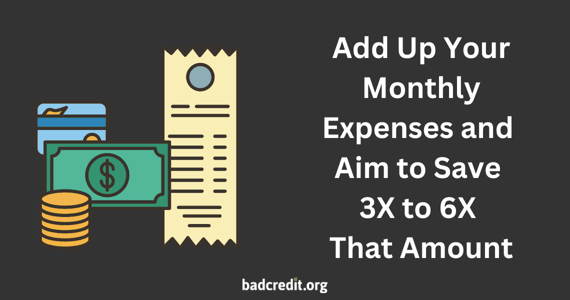
Saving money is a goal many Americans know they need to work toward, but knowing just how much to put away leaves many people feeling puzzled and overwhelmed. According to the Planning and Progress Study from Northwestern Mutual, 48% of respondents say they’re unclear on how much they can afford to spend and how much they should be saving for later.
The truth is, there’s no one-size-fits-all number. The amount of money you should have in your savings account is highly personal and depends greatly on your financial situation and lifestyle. Everyone has a different set of essential expenses based on monthly bills, family size, employment status, debt load, and future goals.
The good news is you can determine just how much money you should save by following a few basic parameters. Once you have a specific target, it’s much easier to create a plan to help you reach that goal faster.
Add Up Your Essential Expenses
The idea of building up a savings account is to help you get through a tough financial time without taking on debt. The extra cash you put away can cover an unexpected bill, urgent repair, medical emergency, or go toward daily and monthly expenses in the event you or your partner lose your job.
Having money set aside in a separate account ensures you can pay your bills and take care of your loved ones without relying on a high-interest credit card during a crisis.
With this in mind, putting away three to six months of living expenses in an emergency savings account is recommended.

For a more exact number, add up your basic expenses, including mortgage or rent, utilities, healthcare, other insurance premiums, loan or debt payments, transportation, childcare, and groceries. Other expenses, like entertainment, dining out and such, are not essential and you would most likely cut down on this type of spending during a financial emergency.
Once you know the amount you spend each month on these core bills, multiply that number by three, four, five, or six, depending on how much you already have saved and how much you want to put away to get your desired savings total.
Saving up to six months of living expenses is a general rule of thumb in the financial world, but don’t let that limit you. You could always save more. In fact, some personal situations call for a bigger savings balance.
If you are self-employed or have irregular income, for instance, consider putting away up to 12 months of your total monthly bills into a separate savings account. Stashing more cash in an emergency fund would also allow you to enjoy optional expenses, such as dining out, beyond your daily necessities. You should also consider this when mapping out your ultimate saving plan.
6 Tricks To Reach Your Savings Goal
You may not have any money saved yet, and that’s okay. The reality is many people have little to nothing saved, so the idea of stashing away this much money may be overwhelming and can keep you from moving forward.
Getting started is the hardest part, so think about how you can make the goal less intimidating if you’re feeling unmotivated. For instance, setting a smaller goal will feel more feasible and give you the boost of confidence needed to persevere.
Aim to save just one month of living expenses. Once you reach this goal, move on from there to keep building up your nest egg.
1. Outline a Budget
Setting a strict budget is key to successfully reaching your savings goal. A spending plan will show you exactly how much you can spend each month on various expenses while hitting your monthly savings target at the same time.
When outlining a budget, identify areas where you should cut back on expenses to make room for savings. This can include dining out, entertainment, and clothing purchases.
2. Pay Yourself First
Treat your savings as you would your most important bill and pay it first. When your extra cash goes directly to saving, it will be out of sight and out of mind, and will reduce the temptation to spend it on an unnecessary purchase. It also forces you to live on less.
3. Automate Your Savings
Setting up automatic transfers to your savings account lowers the level of self-discipline needed to succeed and ensures you stay on task each month. You can automate savings on a weekly or monthly basis and increase the amount over time if you prefer to start off small.
4. Leverage Savings Tools
Your bank or other financial apps may offer savings tools to help you save more money faster. For example, Bank of America’s Keep The Change Program offers to round up purchases to the nearest whole dollar amount and transfer the change from your checking to your savings account. These small amounts of money can add up over time without making a huge dent in your day-to-day spending.
5. Open a High Yield Savings Account
Where you put your savings matters, too. While opening a savings account at the bank where you have a checking account seems the most logical, this move will make you miss out on free money. Instead, open a high-yield online savings account that pays 20 to 25 times more in interest than those offered by traditional savings accounts. Run an online search to find an online savings account that offers the best rate and watch out for fees.
6. Stash Away Your Cash Rewards
Redeem any cash back earned on your credit card to your separate savings account. If you don’t yet have a cash back credit card, look for one that will give you more back for the types of purchases you make the most and use all your earnings to help build up your savings.
Set Yourself Up For Saving Success
Reaching your savings goal may seem a bit overwhelming when you first start, but focusing on one month at a time or smaller goals along the way will feel more feasible. Once you see your savings fund growing, you will feel a sense of accomplishment that will help you stay motivated.




